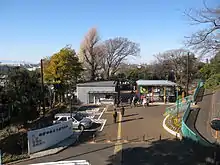Nogeyama Zoo
Nogeyama Zoological Gardens (野毛山動物園, Nogeyama Dōbutsuen) is a free zoo opened in April 1951 and located in Nogeyama Park, in Nishi-ku, Yokohama, Japan. It covers 9.6 hectares (24 acres) and houses about 1400 animals of 100 different species. It is open from 9:30 am to 4:00 pm and is closed on Mondays.
 Entrance to Nogeyama Zoo | |||||
| Date opened | April 1951 [1] | ||||
|---|---|---|---|---|---|
| Location | 63-10 Oimatsu-cho, Nishi-ku, Yokohama, Kanagawa Prefecture, Japan 〒220-0032 | ||||
| Coordinates | 35°26′48″N 139°37′22″E | ||||
| Land area | 9.6 hectares (24 acres) | ||||
| No. of animals | 1416 [2] | ||||
| No. of species | 100 [2] | ||||
| Annual visitors | 680,000 (2009)[1] | ||||
| Memberships | Yokohama City Environmental Department, JAZA [3] | ||||
| Website | www2.nogeyama-zoo.org | ||||
| Japanese name | |||||
| Kanji | 野毛山動物園 | ||||
| Hiragana | のげやま どうぶつえん | ||||
| Katakana | ノゲヤマ ドウブツエン | ||||
| |||||
The zoo is operated by the Yokohama Zoological Garden, and is a member of the Japanese Association of Zoos and Aquariums (JAZA).
Animals
Animals at the zoo include Mandarin ducks, cranes, red pandas, chimpanzees, hamadryas baboons, reptiles, lion, tigers, tanuki (raccoon dogs), badgers, pheasants, love birds, zebras, giraffes, flamingos, camels, ruffed lemurs, white-mantled black colobus, black-capped capuchins, swans, ducks, kagus, penguins, wallaby, deer, eagles, owls, condors, bears, and Tokyo bitterlings.[4]
The red panda is one of the first animals visitors see upon entering the zoo, and also one of the most popular.[5]
Makigahara Children's Zoo
The Makigahara Children's Zoo was opened in 1979 as part of the Nogeyama Zoo.[6] It is primarily home to small animals such as mice, guinea pigs, chickens, and fantail pigeons,[7] and snakes.[5]
Conservation
The Nogeyama Zoo was the first zoo in Japan to successfully house leopards (1952), blackbuck (1953), dromedary (1954), sloth bear (1965), ring-tailed lemur (1969), pileated gibbon and caracal (1974), clouded leopard (1983), giant anteater (1985), Kleinmann's tortoise (1992), Asian forest tortoise (1997), and radiated tortoise (2009). It was also the second zoo in the world to successful breed Andean condors in captivity in 1972. In 2016 the highly endangered Ploughshare tortoise from Madagascar was bred.
Notes
- Ichikawa, Yoshinori. "From the Director". nogeyama-zoo.org (in Japanese). Nogeyama Zoo. Archived from the original on 2010-06-20. Retrieved 12 May 2010.
- "Welcome to the Nogeyama Zoo". nogeyama-zoo.org (in Japanese). Nogeyama Zoo. Archived from the original on 2010-02-18. Retrieved 12 May 2010.
- "List of Zoos" (PDF). jazga.or.jp. Japanese Association of Zoos and Aquariums. Retrieved 12 June 2010.
- "Zoo Map" (PDF). nogeyama-zoo.org (in Japanese). Nogeyama Zoo. Archived from the original (PDF) on 2011-07-27. Retrieved 12 May 2010.
- "Yokohama Nogeyama Zoo". yokohamaliving.com. Yokohama Living. Retrieved 12 May 2010.
- "Makigahara Children's Zoo". nogeyama-zoo.org (in Japanese). Nogeyama Zoo. Archived from the original on 2010-03-14. Retrieved 12 May 2010.
- "Animals". nogeyama-zoo.org (in Japanese). Nogeyama Zoo. Archived from the original on 2010-06-20. Retrieved 12 May 2010.
External links
- Official website (Japanese)
- Nogeyama Zoological Gardens Remembrance and Records (in Japanese)
- Oideyo! Nogeyama Zoo (in Japanese)